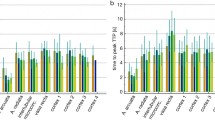Abstract
Iotrolan was compared with iohexol and iopamidol for efficacy and general tolerance in excretory urography in three controlled, randomized, inte-individual, double-blind studies. Two hundred and eighty-four patients received fixed doses of 100 ml, 120 ml or 150 ml iotrolan 280 or iohexol 300/iopamidol 300 by rapid or bolus injection. Contrast quality in films taken 3–40 min after injection was rated by experienced radiologists both on an overall basis and with regard to distinct anatomical regions (parenchyma, pelvicalyceal system, ureter, bladder). In all studies, contrast quality was assessed as better in the iotrolan group. In two studies (dosages 100 and 120 ml), significant differences in contrast quality were found in lavour of iotrolan (P < 0.05), and in the third study (dosage 150 ml) there was a trend towards better contrast quality in the iotrolan group (P = 0.06). General tolerance of iotrolan was good with only minor side effects (iotrolan 6.3%, iohexol/iopamidol 9.9%), but the difference was not significant. No severe adverse reactions were observed with iotrolan. In comparison with non-ionic monomers, iotrolan shows very good efficacy and general tolerance for excretory urography.
Similar content being viewed by others
References
Katzberg RW (1992) The contrast media manual. Williams & Wilkins, Baltimore
Katayama H, Yamaguchi K, Kozuka T, Takashima T, Seez P, Matsuura K (1990) Adverse reactions to ionic and nonionic contrast media: a report from the Japanese committee on the safety of contrast media. Radiology 175: 621–628
Wolf GL, Arenson RL, Cross AP (1989) A prospective trial of ionic vs nonionic contrast agents in routine clinical practice: Comparison of adverse effects. Am J Radiol 152: 939–944
Palmer FJ (1988) The RACR survey of intravenous contrast media reactions: final report. Australasian Radiology 32: 426–428
Barrett BJ, Carlisle EJ (1993) Meta-analysis of the relative nephrotoxicity of high and low-osmolality iodinated contrast media. Radiology 188: 171–178
Sovak M, Ranganathan R, Speck U (1982) Nonionic dimer: development and initial testing of an intrathecal contrast agent. Radiology 142: 115–118
Mutzel W, Press WR, Weinmann HJ (1989) Physicochemical properties and general pharmacology of the nonionic dimer iotrolan. In: Taenzer V, Wende S (eds) Recent developments in nonionic contrast media. Thieme, Stuttgart, pp 28–32
Ringel K, Klotz E, Wenzel-Hora BI (1989) Iotrolan versus iopamidol: a controlled, multicenter, double-blind study of lumbar and direct cervical myelography. In: Taenzer V, Wende S (eds) Recent developments in nonionic contrast media. Thieme, Stuttgart, pp 153–157
Hagen B, Wenzel-Hora BI (1989) Initial experience with a nonionic, dimeric contrast medium (Iotrolan) in direct and indirect arteriorgraphy: a randomized, intraindividual double-blind study in 60 patients. In: Taenzer V, Wende S (eds) Recent developments in nonionic, contrast media. Thieme, Stuttgart, pp 54–60
Nauert C, Mutzel W (1989) Experimental urography in Dogs: diagnostic quality and pharmacokinetic behaviour of iotrolan in comparison to nonionic and ionic, monomeric contrast media. In: Taenzer V, Wende S (eds) Recent developments in nonionic contrast media. Thieme, Stuttgart, pp 82–87
Choyke PL (1992) The urogram: are rumors of its death premature? Devil's advocate. Radiology 184: 33–36
Morris TW (1993) X-ray contrast media: where are we now, and where are we going? State-of-art review. Radiology 188: 11–16
Spataro RF, Fischer HW, Boylan L (1982) Urography with low osmolality contrast media. Comparative urinary excretion of iopamidol, hexabrix, and diatrizoate. Invest Radiol 17: 494–500
Benness G, Evill C, Wilcox J, Hassam R, Arozoo E (1989) Renal excretion and computed tomography enhancement of iotrolan and iopamidol in dogs. In: Taenzer V, Wende S (eds) Recent developments in nonionic contrast media. Thieme, Stuttgart, pp 88–90
Taenzer V, Wenzel-Hora BI (1989) Urography with monomeric and dimeric nonionic contrast media: comparative, randomized, double-blind study of iotrolan 280 and iopromide 300. In: Taenzer V, Wende S (eds) Recent developments in nonionic contrast media. Thieme, Stuttgart, pp 116–118
Dure-Smith P, Simenhoff MB, Zimskind PD, Kodroff M (1971) The bolus effect in excretory urography. Radiology 101: 29–34
Barrett BJ, Parfrey PS, McDonald JR, Hefferton DM, Rajaram Reddy E, McManamon PJ (1992) Nonionic low-osmolality versus ionic high-osmolality contrast material for intravenous use in patients perceived to be at high risk: randomized trial. Radiology 183: 105–110
Katholi RE, Taylor GJ, Woods TW, Womack KA, Katholi CR, McCann WP, et al. (1993) Nephrotoxicity of nonionic low-osmolatity versus ionic high-osmolality contrast media: a prospective double-blind randomized comparison in human beings. Radiology 186: 183–187
Author information
Authors and Affiliations
Rights and permissions
About this article
Cite this article
Adolph, J.M.G., Engelkamp, H., Herbig, W. et al. Iotrolan in urography: efficacy and tolerance in comparison with iohexol and iopamidol. Eur. Radiol. 5 (Suppl 2), S63–S68 (1995). https://doi.org/10.1007/BF02343264
Issue Date:
DOI: https://doi.org/10.1007/BF02343264




